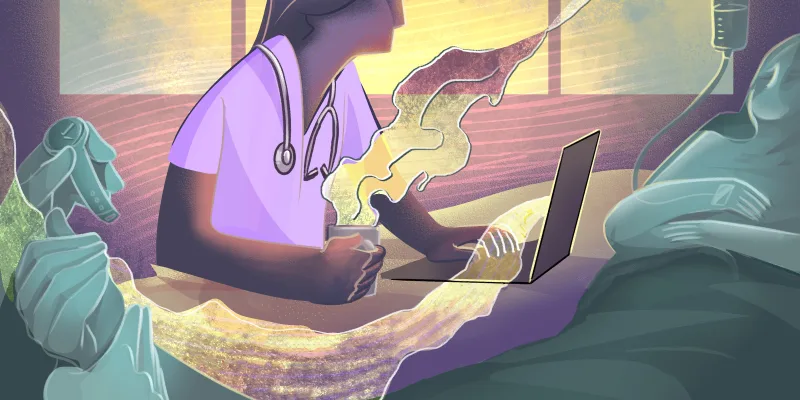 My patient was a young man in his early 20s who wanted to be placed back on buprenorphine. He had started using again. He often missed appointments, did not pick up phone calls. So when I saw him in the room, I masked my surprise.
My patient was a young man in his early 20s who wanted to be placed back on buprenorphine. He had started using again. He often missed appointments, did not pick up phone calls. So when I saw him in the room, I masked my surprise.
“What makes you want to start today?” I asked.
“I live with my grandma,” he said. He could not keep leaving the house for heroin.
Of the many issues that undergird health care delivery in the age of COVID-19, medication-assisted treatment (MAT) is one of the most compelling alarms for broader structural changes during and after this pandemic. I work in a clinic that serves as a medical home for people who have interfaced with the juvenile justice system. The clinic is one of the few which will remain open during the pandemic. As jails and group homes try to lessen their numbers, the number of patients who need to connect with care for the first time will only increase — as will the demand to start or continue MAT.
In my pre-pandemic haze, I saw physicians’ control over buprenorphine scripts as a kind of safeguard for ensuring longitudinal care. There was an incentive for patients to come to their appointments, during which time they might reveal career goals, a desire to start a family, a fear of dying. MAT was a bridge toward a trusting relationship with a provider.
Now, the “safeguard” I hoped for has given way to unfettered bureaucracy. Even as poisoning (including opioid overdose) has become the leading cause of accidental death, buprenorphine has remained a tightly regulated drug. Providers must complete an 8-hour training course in order to obtain a prescription waiver, and there are a limited number of patients that providers can treat: 30 in the first year and a maximum of 275.
With COVID-19, we have both a unique opportunity and need to deregulate buprenorphine prescriptions. The Substance Abuse and Mental Health Services Administration (SAHMSA) recently updated guidelines for buprenorphine during the pandemic. There are new provisions for telephonic initiation of buprenorphine and scripts up to 28 days for stable patients. Unfortunately, this does not circumvent the major issue: fewer than 10% of providers nationally are authorized to prescribe buprenorphine, resulting in a disconcertingly small window for care.
This crisis is an opportunity to reform and strengthen MAT access — and there are three ways to do it.
First, at this time, not all pharmacies have the capacity to accept electronic scripts for controlled substances; electronic scripts are the easiest means to ensure that patients do not have to leave their homes for prescription pick-ups. In some places, statewide prescription monitoring databases monitor an individual’s record for controlled substance prescriptions, making it easy to safely refill buprenorphine. We also need to authorize telephonic refills. Pharmacists can be trained to ask standardized security questions (provided by physicians) prior to filling scripts. There are other options available, but the bottom line is: we need to universally implement mechanisms for rapid access.
Second, we need to expand training for buprenorphine initiation and management. Because there is a dearth of addiction medicine in medical education, trainees lack opportunities to become interested, and therefore involved, addiction medicine during times of crisis. Increasing access to buprenorphine is contingent upon increasing the number of providers with a waiver to prescribe. Given the number of furloughed mid-level practitioners during COVID-19, we could effectively use this time to build capacity for MAT management. SAHMSA has given some flexibility that permits certified mid-levels to prescribe MAT without direct physician supervision — but the need for MAT access will continue to rise, compounded by reorganization of residential treatment facilities and detention centers. Our clinic is already finding itself overwhelmed with an uptick of referrals from such facilities. We are left telling families and patients to wait: we don’t have enough providers, we need to space out visits. And every week we forego the opportunity to intervene sooner and keep our highest-risk patients at home.
Third, we need to liberalize the length of prescriptions. Prior to COVID-19, buprenorphine prescriptions were dispensed for two-week intervals. Under new guidance from SAHSMA, scripts can now be extended to 28 days — a thoughtful, but incomplete solution. We need to consider patients on a case-by-case basis and allow them at least one refill from home. With COVID-19, barriers to care — such as housing instability, unemployment, and transportation — are only exacerbated; patients are at increased risk of not being able to connect with a provider. Substance use disorder should elicit the same allowances other chronic disease sufferers are afforded. While there is a risk of hoarding or diversion, that risk is minimal compared with the risk of a patient returning to the street for heroin.
One of my patients has been in recovery for several years. She continues to struggle with methamphetamine use, even on buprenorphine. Even before the pandemic, she turned to methamphetamine when she ran out of buprenorphine and could not make it in for a new script. But when I saw her in February, she was beaming. She’d joined a church, thought about dating, and gotten a car. And then the pandemic hit. Now, she is struggling again — this time, without the relationships embedded in non-pandemic clinical care. The least we can do is ensure that she does not risk interruption of her MAT.
Structural inequities undergird so much of opioid use disorder: they create, enforce, and exacerbate it. If we were blind to it before, we are now acutely aware that our personal choices are both created and limited by our political choices. We don’t need to wait for the pandemic to end before we re-envision both our choices and our politics.
Megana Dwarakanath is a third-year pediatrics resident at the University of New Mexico. She will start an adolescent medicine fellowship at UPMC in July. She is interested in adolescent substance use disorder.
Illustration by April Brust
Click here to see more perspectives on COVID-19 from the Doximity network.
Click here for up-to-date news about COVID-19 on Doximity.






